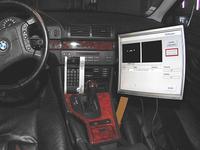-
Manchester, New Hampshire police orders 250 X2 ECD
Manchester, new Hampshire police department deploys 250 TASER X2 ECD, the largest such deployment in New England
-
-
California bill prohibiting use of license plate readers dies in state Senate

Facing growing pressure from law enforcement agencies in the state, and a concerted effort by technology and insurance companies, the sponsors of a bill which would prohibit the use and storage of License Plate Recognition (LPR) data, decided not to bring the bill to a vote on the California Senate floor
-
-
Mantis shrimp could inspire new body, vehicle armor

The unique and highly complex structure of fist-like club of mantis shrimp could transform materials used to create military body armor and vehicle and aircraft frames
-
-
Using mathematical modeling to predict burglary patterns
Pattern formation in physical, biological, and sociological systems has been studied for many years; despite the fact that these subject areas are diverse, the mathematics that describes underlying patterns in these systems can be surprisingly similar; mathematical tools can be used to study such systems and predict their patterns
-
-
Movie-like emergency training system for law enforcement
Raytheon’s VIRTSIM law-enforcement training system employs licensed motion-capture technology similar to that used in movies such as “Lord of the Rings,” “Avatar,” and, most recently, “The Avengers”; the system is being offered to the law enforcement community as an affordable, twenty-first century alternative to outdated training practices that do little to replicate real-life situations
-
-
NYC launches on-line auction of city fleet vehicles
New York City operates 27,000 vehicles and equipment pieces covering sixty city agencies; each year, up to 2,500 of these vehicles are replaced by newer equipment and sold by auction to the general public; now customers can access hundreds of desirable vehicles with the convenience of an online auction
-
-
Atlantic City deploys ShotSpotter
The Atlantic City, New Jersey, Police Department is deploying SST’s ShotSpotter Flexsolution to detect and locate gunfire incidents and gather gunfire intelligence
-
-
Surveillance and evidence capture tool comes to U.S.
Evidence collection, location data, surveillance, and illumination all rolled into one handheld torch is making its U.S. debut at the Special Operations Forces Industry Conference (SOFIC) and Exposition, Tampa Convention Centre, Florida, from 22 to 24 May 2012
-
-
Panasonic shows wearable camera for law enforcement
Toughbook mobile computer and Toughbook Arbitrator digital video interoperability offer advantages to law enforcement and public safety agencies; adopting body-worn video solutions is a complement to in-car platforms providing video directly from the officer’s vantage point
-
-
FAA moves on integrating drones into U.S. airspace

The Federal Aviation Administration (FAA) now allows a government public safety agency and first responders to operate drones weighing 4.4 pounds or less in the U.S. air space, but under certain restrictions: these drones should be used for training and performance evaluation, they must be flown within the line of sight of the operator, less than 400 feet above the ground, during daylight conditions, inside Class G (uncontrolled) airspace, and more than five miles from any airport or other location with aviation activities; the FAA says that if safety agencies then apply for a waiver, the agency will allow the operation of drones weighing up to twenty-five pounds
-
-
Ohio University students develop 3-D maps to help first responders
A group of Ohio University students has created a 3-D building mapping program to help first responders in safely responding to emergencies ranging from fires to terrorist attacks
-
-
High-tech license plate readers effective, but raise ethical issues
The use of license-plate readers by police is growing, raising privacy concerns; cameras mounted atop the cruiser capture thousands of images a day; a computer inside the car checks the license plates against various crime databases, including wanted suspects, stolen vehicles, and sex offenders
-
-
FBI seeking wiretap-ready Web
As communications have changed in recent years from the traditional telephone system to the Internet, the FBI has found itself facing greater difficulty in carrying out surveillance operations; the agency is asking Internet companies not to oppose a coming proposal which would require them to provide a surveillance backdoor
-
-
LMR market to reach $16.2 billion by 2017
Next generation mobile/wireless technologies continue to suffer from coverage and reliability issues, which are key considerations for law enforcement, emergency medical services, disaster recovery, and other public safety applications; as a result, a large number of critical services continue to remain committed to narrowband analog connectivity such as a Land Mobile Radio network; this is good news for the future of the LMR market.
-
-
Stun guns increase chances of citizen injury, but protect police officers

Across the United States, some 260,000 electronic control devices, or stun guns, are in use in 11,500 law enforcement agencies; the use of these stun guns by police significantly increases the chances of citizen injury, yet also protects the officers more than other restraint methods, according to the most comprehensive research to date into the safety of stun guns in a law enforcement setting
-
- All
- Regional
- Water
- Biometrics
- Borders/Immig
- Business
- Cybersecurity
- Detection
- Disasters
- Government
- Infrastructure
- International
- Public health
- Public Safety
- Communication interoperabillity
- Emergency services
- Emergency medical services
- Fire
- First response
- IEDs
- Law Enforcement
- Law Enforcement Technology
- Military technology
- Nonlethal weapons
- Nuclear weapons
- Personal protection equipment
- Police
- Notification /alert systems
- Situational awareness
- Weapons systems
- Sci-Tech
- Sector Reports
- Surveillance
- Transportation
Advertising & Marketing: advertise@newswirepubs.com
Editorial: editor@newswirepubs.com
General: info@newswirepubs.com
2010-2011 © News Wire Publications, LLC News Wire Publications, LLC
220 Old Country Road | Suite 200 | Mineola | New York | 11501
Permissions and Policies
Editorial: editor@newswirepubs.com
General: info@newswirepubs.com
2010-2011 © News Wire Publications, LLC News Wire Publications, LLC
220 Old Country Road | Suite 200 | Mineola | New York | 11501
Permissions and Policies
